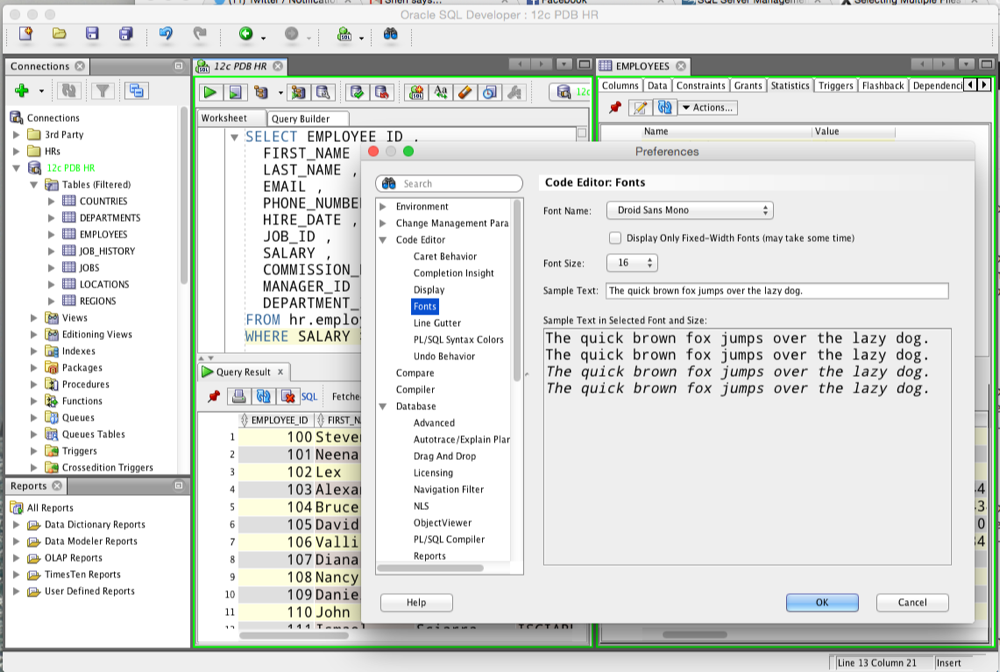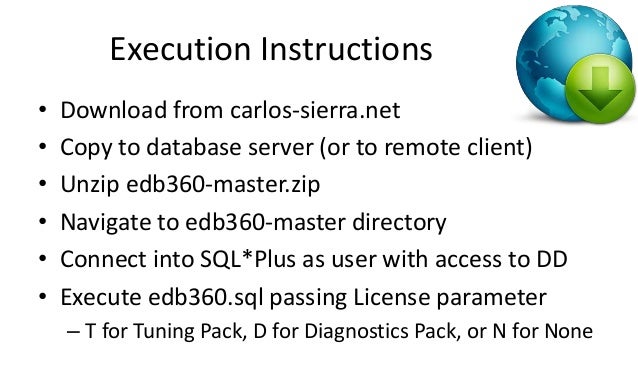Jun 07, 2019 SQL.Plus Version 12.2.0.1.0. Navigate to Oracle downloads, accept the license agreement, and login. If you don’t already have an Oracle account, you’ll need to create one. Download these zip files: instantclient-basic-macos.x64-12.2.0.1.0-2.zip. Make dir for instant client then unzip zips. The first step is to create a folder for the image. Mkdir /oracledata. Now we create a container and mount it in the latest folder using the oracle-12c image. The command will also run the. Here a simple Windows batch file, which calls the SQL script above, decodes the file and deletes the base64 version. File export.bat. Echo exit sqlplus -S demo/oracle@localhost:1521/xepdb1 @export.sql certutil -decode app100.zip.base64 app100.zip del app100.zip.base64. The described method to download a BLOB is independent of the package.
Have you ever tried to spool/download BLOBS with SQL*Plus? Some months ago I tried to find a way to download a collection of CLOBs or even better a zipped version of the collection as BLOB. I learned that BLOBs are not a valid datatype in SQL*Plus when it comes to the spool command. I found a way by putting the CLOBs into a global temporary table, creating an intermediate SQL script with tons of select and spool commands, and finally spooling the CLOBs one by one by calling the intermediate SQL script. It was working, but far from elegant. Also, when I was in the home office with a less powerful connection, it was slowing down the whole export process significantly.
If you are using PLEX (PL/SQL Export Utilities) and this sounds familiar to you - the described method was the default for exporting an APEX app or your schema DDL with the delivered export script templates.

If you have no idea what I am talking about: PLEX is a PL/SQL package that is able to export an Oracle APEX app, ORDS modules, all schema objects and table data into a nice directory structure in one go ready to use for version control. Check out the project on GitHub and this blog post on how to get started.

But there is a better way: Simply convert the BLOB into a base64 encoded CLOB. I have no idea why this was not my first solution for the PLEX export templates. In the new version 2.1.0 of PLEX the templates are using this approach. Here is a simplified example.

Sql Plus Download For Mac
File export.sql:
Congratulations - You are the owner of a base64 encoded CLOB on your client disk. And now? Before you can unzip the file you need to decode it - depending on your operating system you can do this with your OS tools:
- Windows:
certutil -decode app_100.zip.base64 app_100.zip - Mac:
base64 -D -i app_100.zip.base64 -o app_100.zip - Linux:
base64 -d app_100.zip.base64 > app_100.zip
Here a simple Windows batch file, which calls the SQL script above, decodes the file and deletes the base64 version.
File export.bat
The described method to download a BLOB is independent of the package PLEX - you only need a small helper function to encode the BLOB. I found an example provided by Tim Hall on his Oracle Base site. Thanks for sharing Tim!

This function is included in the newest version of PLEX (named to_base64) - you can download PLEX here.
Happy scripting, exporting and version controlling :-)

Ottmar
Here I’ll show you how to get SQL Server up and running on your Mac in less than half an hour. And the best part is, you’ll have SQL Server running locally without needing any virtualization software.
Prior to SQL Server 2017, if you wanted to run SQL Server on your Mac, you first had to create a virtual machine (using VirtualBox, Parallels Desktop, VMware Fusion, or Bootcamp), then install Windows onto that VM, then finally SQL Server. This is still a valid option depending on your requirements (here’s how to install SQL Server on a Mac with VirtualBox if you’d like to try that method).
Starting with SQL Server 2017, you can now install SQL Server directly on to a Linux machine. And because macOS is Unix based (and Linux is Unix based), you can run SQL Server for Linux on your Mac. The way to do this is to run SQL Server on Docker.
So let’s go ahead and install Docker. Then we’ll download and install SQL Server.
Sql Plus Download Mac Os
Install Docker
Download the (free) Docker Community Edition for Mac (unless you’ve already got it installed on your system). This will enable you to run SQL Server from within a Docker container.
To download, visit the Docker CE for Mac download page and click Get Docker.
To install, double-click on the .dmg file and then drag the Docker.app icon to your Application folder.
What is Docker?
Docker is a platform that enables software to run in its own isolated environment. SQL Server (from 2017) can be run on Docker in its own isolated container. Once Docker is installed, you simply download — or “pull” — the SQL Server on Linux Docker Image to your Mac, then run it as a Docker container. This container is an isolated environment that contains everything SQL Server needs to run.
Launch Docker
Launch Docker the same way you’d launch any other application (eg, via the Applications folder, the Launchpad, etc).
When you open Docker, you might be prompted for your password so that Docker can install its networking components and links to the Docker apps. Go ahead and provide your password, as Docker needs this to run.
Increase the Memory (optional)
By default, Docker will have 2GB of memory allocated to it. SQL Server needs at least 2GB. However, it won’t hurt to increase it if you can.
In my case, I increased it to 4GB.
To do this, select Preferences from the little Docker icon in the top menu:
Then finish off by clicking Apply & Restart
Download SQL Server
Now that Docker is installed, we can download and install SQL Server for Linux.
Open a Terminal window and run the following command.
This downloads the latest SQL Server 2019 for Linux Docker image to your computer.
You can also check for the latest container version on the Docker website if you wish.
Launch the Docker Image
Run the following command to launch an instance of the Docker image you just downloaded:
But of course, use your own name and password. Also, if you downloaded a different Docker image, replace
mcr.microsoft.com/mssql/server:2019-latestwith the one you downloaded.Here’s an explanation of the parameters:
-dThis optional parameter launches the Docker container in daemon mode. This means that it runs in the background and doesn’t need its own Terminal window open. You can omit this parameter to have the container run in its own Terminal window. --name sql_server_demoAnother optional parameter. This parameter allows you to name the container. This can be handy when stopping and starting your container from the Terminal. -e 'ACCEPT_EULA=Y'The Yshows that you agree with the EULA (End User Licence Agreement). This is required in order to have SQL Server for Linux run on your Mac.-e 'SA_PASSWORD=reallyStrongPwd123'Required parameter that sets the sadatabase password.-p 1433:1433This maps the local port 1433 to port 1433 on the container. This is the default TCP port that SQL Server uses to listen for connections. mcr.microsoft.com/mssql/server:2019-latestThis tells Docker which image to use. If you downloaded a different one, use it instead. Password Strength
If you get the following error at this step, try again, but with a stronger password.
I received this error when using
reallyStrongPwdas the password (but of course, it’s not a really strong password!). I was able to overcome this by adding some numbers to the end. However, if it wasn’t just a demo I’d definitely make it stronger than a few dictionary words and numbers.Check the Docker container (optional)
You can type the following command to check that the Docker container is running.
If it’s up and running, it should return something like this:
Install sql-cli (unless already installed)
Run the following command to install the sql-cli command line tool. This tool allows you to run queries and other commands against your SQL Server instance.
This assumes you have NodeJs installed. If you don’t, download it from Nodejs.org first. Installing NodeJs will automatically install npm which is what we use in this command to install sql-cli.
Permissions Error?
If you get an error, and part of it reads something like
Please try running this command again as root/Administrator
, try again, but this time prependsudoto your command:Connect to SQL Server
Now that sql-cli is installed, we can start working with SQL Server via the Terminal window on our Mac.
Connect to SQL Server using the
mssqlcommand, followed by the username and password parameters.You should see something like this:
This means you’ve successfully connected to your instance of SQL Server.
Run a Quick Test
Run a quick test to check that SQL Server is up and running and you can query it.
For example, you can run the following command to see which version of SQL Server your running:
If it’s running, you should see something like this (but of course, this will depend on which version you’re running):
If you see a message like this, congratulations — SQL Server is now up and running on your Mac!
You can now go ahead and run SQL queries against SQL Server.
See my free SQL Tutorial for Beginners to get started with writing simple queries against SQL Server.
A SQL Server GUI for your Mac – Azure Data Studio
Azure Data Studio (formerly SQL Operations Studio) is a free GUI management tool that you can use to manage SQL Server on your Mac. You can use it to create and manage databases, write queries, backup and restore databases, and more.
Azure Data Studio is available on Windows, Mac and Linux.
Here are some articles/tutorials I’ve written for Azure Data Studio:
Sql Plus Free Download
Another Free SQL Server GUI – DBeaver
Another SQL Server GUI tool that you can use on your Mac (and Windows/Linux/Solaris) is DBeaver.
DBeaver is a free, open source database management tool that can be used on most database management systems (such as MySQL, PostgreSQL, MariaDB, SQLite, Oracle, DB2, SQL Server, Sybase, Microsoft Access, Teradata, Firebird, Derby, and more).
I wrote a little introduction to DBeaver, or you can go straight to the DBeaver download page and try it out with your new SQL Server installation.
Limitations of SQL Server for Linux/Mac
Sqlplus Download Linux
SQL Server for Linux does have some limitations when compared to the Windows editions (although this could change over time). The Linux release doesn’t include many of the extra services that are available in the Windows release, such as Analysis Services, Reporting Services, etc. Here’s a list of what’s available and what’s not on SQL Server 2017 for Linux and here’s Microsoft’s list of Editions and supported features of SQL Server 2019 on Linux.
Sql Plus Download Mac Version
Another limitation is that SQL Server Management Studio is not available on Mac or Linux. SSMS a full-blown GUI management for SQL Server, and it provides many more features than Azure Data Studio and DBeaver (at least at the time of writing). You can still use SSMS on a Windows machine to connect to SQL Server on a Linux or Mac machine, but you just can’t install it locally on the Linux or Mac machine.
Download Sql Plus 64 Bit
If you need any of the features not supported in SQL Server for Linux, you’ll need SQL Server for Windows. However, you can still run SQL Server for Windows on your Mac by using virtualization software. Here’s how to install SQL Server for Windows on a Mac using VirtualBox.